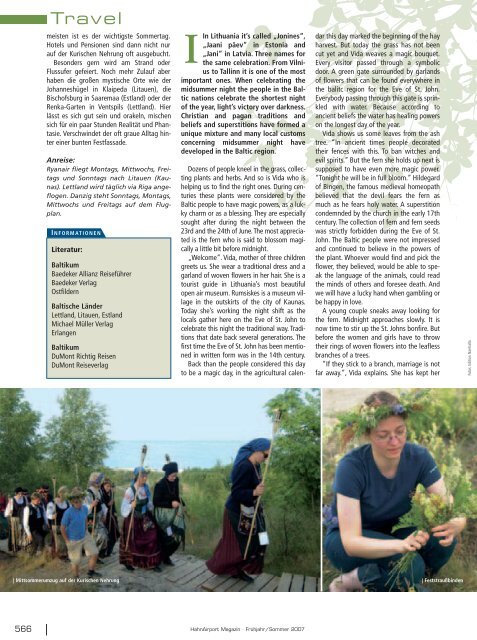Mittsommer - HahnAirport Magazin
Mittsommer - HahnAirport Magazin
Mittsommer - HahnAirport Magazin
Sie wollen auch ein ePaper? Erhöhen Sie die Reichweite Ihrer Titel.
YUMPU macht aus Druck-PDFs automatisch weboptimierte ePaper, die Google liebt.
566<br />
Travel<br />
meisten ist es der wichtigste Sommertag.<br />
Hotels und Pensionen sind dann nicht nur<br />
auf der Kurischen Nehrung oft ausgebucht.<br />
Besonders gern wird am Strand oder<br />
Flussufer gefeiert. Noch mehr Zulauf aber<br />
haben die großen mystische Orte wie der<br />
Johanneshügel in Klaipeda (Litauen), die<br />
Bischofsburg in Saaremaa (Estland) oder der<br />
Renka-Garten in Ventspils (Lettland). Hier<br />
lässt es sich gut sein und orakeln, mischen<br />
sich für ein paar Stunden Realität und Phantasie.<br />
Verschwindet der oft graue Alltag hinter<br />
einer bunten Festfassade.<br />
Anreise:<br />
Ryanair fliegt Montags, Mittwochs, Freitags<br />
und Sonntags nach Litauen (Kaunas).<br />
Lettland wird täglich via Riga angeflogen.<br />
Danzig steht Sonntags, Montags,<br />
Mittwochs und Freitags auf dem Flugplan.<br />
I NFORMATIONEN<br />
Literatur:<br />
Baltikum<br />
Baedeker Allianz Reiseführer<br />
Baedeker Verlag<br />
Ostfildern<br />
Baltische Länder<br />
Lettland, Litauen, Estland<br />
Michael Müller Verlag<br />
Erlangen<br />
Baltikum<br />
DuMont Richtig Reisen<br />
DuMont Reiseverlag<br />
IIn Lithuania it’s called „Jonines“,<br />
„Jaani päev“ in Estonia and<br />
„Jani“ in Latvia. Three names for<br />
the same celebration. From Vilnius<br />
to Tallinn it is one of the most<br />
important ones. When celebrating the<br />
midsummer night the people in the Baltic<br />
nations celebrate the shortest night<br />
of the year, light’s victory over darkness.<br />
Christian and pagan traditions and<br />
beliefs and superstitions have formed a<br />
unique mixture and many local customs<br />
concerning midsummer night have<br />
developed in the Baltic region.<br />
Dozens of people kneel in the grass, collecting<br />
plants and herbs. And so is Vida who is<br />
helping us to find the right ones. During centuries<br />
these plants were considered by the<br />
Baltic people to have magic powers, as a lukky<br />
charm or as a blessing. They are especially<br />
sought after during the night between the<br />
23rd and the 24th of June. The most appreciated<br />
is the fern who is said to blossom magically<br />
a little bit before midnight.<br />
„Welcome“. Vida, mother of three children<br />
greets us. She wear a traditional dress and a<br />
garland of woven flowers in her hair. She is a<br />
tourist guide in Lithuania’s most beautiful<br />
open air museum. Rumsiskes is a museum village<br />
in the outskirts of the city of Kaunas.<br />
Today she’s working the night shift as the<br />
locals gather here on the Eve of St. John to<br />
celebrate this night the traditional way. Traditions<br />
that date back several generations. The<br />
first time the Eve of St. John has been mentioned<br />
in written form was in the 14th century.<br />
Back than the people considered this day<br />
to be a magic day, in the agricultural calen-<br />
<strong>HahnAirport</strong> <strong>Magazin</strong> · Frühjahr/Sommer 2007<br />
dar this day marked the beginning of the hay<br />
harvest. But today the grass has not been<br />
cut yet and Vida weaves a magic bouquet.<br />
Every visitor passed through a symbolic<br />
door. A green gate surrounded by garlands<br />
of flowers that can be found everywhere in<br />
the balitc region for the Eve of St. John.<br />
Everybody passing through this gate is sprinkled<br />
with water. Because according to<br />
ancient beliefs the water has healing powers<br />
on the longest day of the year.<br />
Vida shows us some leaves from the ash<br />
tree. “In ancient times people decorated<br />
their fences with this. To ban witches and<br />
evil spirits.” But the fern she holds up next is<br />
supposed to have even more magic power.<br />
“Tonight he will be in full bloom.” Hildegard<br />
of Bingen, the famous medieval homeopath<br />
believed that the devil fears the fern as<br />
much as he fears holy water. A superstition<br />
condemnded by the church in the early 17th<br />
century. The collection of fern and fern seeds<br />
was strictly forbidden during the Eve of St.<br />
John. The Baltic people were not impressed<br />
and continued to believe in the powers of<br />
the plant. Whoever would find and pick the<br />
flower, they believed, would be able to speak<br />
the language of the animals, could read<br />
the minds of others and foresee death. And<br />
we will have a lucky hand when gambling or<br />
be happy in love.<br />
A young couple sneaks away looking for<br />
the fern. Midnight approaches slowly. It is<br />
now time to stir up the St. Johns bonfire. But<br />
before the women and girls have to throw<br />
their rings of woven flowers into the leafless<br />
branches of a trees.<br />
“If they stick to a branch, marriage is not<br />
far away.”, Vida explains. She has kept her<br />
| <strong>Mittsommer</strong>umzug auf der Kurischen Nehrung | Feststraußbinden<br />
Fotos: Edition Narrhalla







